Colors play a vital role in our lives—from the visual appeal of foods to industrial and aesthetic applications in various products. One of the most sensitive areas in which color is used is the food and pharmaceutical industries. Edible and non edible colors not only enhance the appearance of products but can also directly impact human health. Understanding the differences, chemical compositions, and safety levels of these colors is essential for both consumers and manufacturers. Key factors in ensuring safety include knowing the chemical makeup, the source of the color, legal approvals, and purchasing from reputable suppliers. In this article, we will examine this subject in detail.
What Is Edible Color?
Food colors are substances used to color food, beverages, medicine, or other edible products. These colors are either naturally derived or synthetic. Their purpose is to increase visual appeal or compensate for color loss during production or storage.
Types of Edible Colors
- Natural Food Colors
These are obtained from natural sources like plants, fruits, vegetables, and even certain insects. Examples include:
- Chlorophyll (green color from plants)
- Carotenoids (yellow to orange from carrots, peppers, etc.)
- Anthocyanins (red to blue from berries)
- Cochineal carmine (red from a type of insect)
- Synthetic Food Colors
Produced in laboratories using chemical compounds. These usually have more stability and stronger colors. Examples include:
- Tartrazine (E102) – Yellow
- Azorubine (E122) – Red
- Brilliant Blue FCF (E133) – Blue
What Is Non-Edible Color?
Non-edible colors are substances intended for use outside the food chain. They may be used in industries such as textiles, paints, packaging, cosmetics, and cleaning products. These colors are generally not safe for human consumption and may cause serious health issues if ingested.
Differences Between Edible and Non Edible Colors
| Feature | Edible Color | Non-Edible Color |
| Application | Food, beverages, medicine, cosmetics (safe for use) | Textiles, plastics, paints, leather, glue, paper, etc. |
| Safety | Safe for human consumption (in allowed quantities) | Dangerous and prohibited for oral intake |
| Source | Natural or safe synthetic sources | Usually chemical, may contain heavy metals/toxins |
| Regulation | Controlled by Food & Drug Authorities (e.g. E-codes) | Usually not approved for food use |
| Price | Generally more expensive | Cheaper but risky if misused |
| Examples | Tartrazine (E102), Chlorophyll, Anthocyanins | Industrial dyes like Methylene Blue, Alizarin, Phthalocyanine |
❗ Why Is This Difference Important?
Using non-edible colors in food can lead to:
- Poisoning
- Severe allergic reactions
- Liver and kidney damage
- Increased risk of cancer
How to Identify Edible Colors?
- Label includes an E-code (e.g. E110, E160)
- Approved by the Food and Drug Administration
- Purchased from reputable suppliers
- Clear chemical and physical information on packaging
Chemical Composition and Safety Effects
In Edible Colors:
Organizations like the FDA (U.S. Food & Drug Administration) and EFSA (European Food Safety Authority) evaluate the chemical compounds in food colors and approve only those deemed safe. Each color has an Acceptable Daily Intake (ADI).
Example:
- Tartrazine is synthetic but considered safe within allowed limits. However, some individuals may experience allergies or sensitivity.
In Non-Edible Colors:
Many contain heavy metals (like lead, chromium, arsenic) or toxic aromatic compounds. Contact with food can cause cancer, neurological issues, or liver problems.
Dangers of Misusing Non-Edible Colors
In some cases—especially in unregulated markets—non-edible colors are wrongly or fraudulently used in food production. This can lead to:
- Acute or chronic poisoning
- Severe allergic reactions
- Growth disorders in children
- Increased cancer risk
These risks often arise from lack of regulation, ignorance, or attempts to cut costs.
How to Distinguish Between Edible and Non Edible Colors
- Accurate labeling: Authorized products usually have E-codes (e.g., E133)
- Purchase from trusted sources: Well-known chemical suppliers or specialty stores
- Health certification: Health permit number or FDA approval on packaging
- Quality control lab testing: Recommended for industrial applications
Uses of Edible Colors
Edible colors are used in many food, pharmaceutical, and cosmetic products to enhance appearance, replace natural color lost during processing, or differentiate products.
- Food Industry
Used for visual appeal, stimulating appetite, and replacing lost color.
- Beverages: soft drinks, juices, syrups
- Sweets & baked goods: creams, jellies, icing, candies
- Dairy: ice cream, fruit yogurt, flavored cheese
- Snacks & processed foods: chips, sausages, cold cuts
- Preserves & pickles: colored olives, processed pickles
- Pharmaceutical Industry
Used for:
- Tablets and capsules (different colors for different doses)
- Children’s syrups (flavor and color appeal)
- Vitamins and supplements
- Edible Cosmetics
Products that may be unintentionally ingested must use food-safe colors:
- Lipstick
- Toothpaste
- Oral sprays
- Children’s Products
- Gum, jelly candies, colorful lollipops
- Cake decorating colors for birthdays
- Chewable supplements
- Special Use (Home or Educational)
- Coloring cakes and desserts at home
- Safe colors for science experiments in schools
⚠️ Safety Note
Although approved and safe, food colors must:
- Be used within permitted limits (as per ADI)
- Excessive consumption of some synthetic colors may cause sensitivity or hyperactivity in children (e.g., Tartrazine)
Standards and Approvals for Food Colors
In Iran, the Food and Drug Organization under the Ministry of Health is responsible for monitoring the safety of food colors. Only those on its approved list can be used in the food industry. Imported colors must also have proper licenses and declared sources.
Role of Reputable Suppliers in Ensuring Safety
Trusted suppliers play a critical role in consumer safety by providing genuine chemical materials and colors. Companies that offer food-grade colors meeting international standards from reputable brands help reduce health risks.
Example:
Suppliers like Aref chemical, by offering original chemicals with standard packaging, detailed specifications, and expert consultation, help ensure the final product’s quality and safety.
Where Did the Idea of Food Coloring Come From?
The concept dates back centuries, rooted in the human desire to beautify food, stimulate appetite, and compensate for color loss during processing.
Historically, people used natural sources like beets (red), turmeric (yellow), spinach (green), and carrots (orange) for food coloring. These colors often had therapeutic properties as well.
With the advancement of chemistry, the first synthetic food colors were developed in the 19th century. The first synthetic dye (e.g., Tartrazine) was derived from coal. Initially, colors were used without regulation and were sometimes toxic.
Due to poisonings from unregulated dyes, governments started implementing food safety laws. Today, food colors must be approved and standardized by organizations like the FDA (U.S.), EFSA (Europe), and Iran’s Ministry of Health.
The idea of food coloring was born from a combination of aesthetic need, food differentiation, and chemical science. What began as a simple idea has now become a vast, scientifically regulated industry focused on enhancing the attractiveness and safety of food.
Conclusion
Using colors in food and other products, if done correctly and in accordance with standards, not only poses no problem but also improves the consumer experience. However, distinguishing between edible and non edible colors is crucial and must be strictly observed. With informed choices, we can enjoy the beauty of colors without compromising our health or that of others.

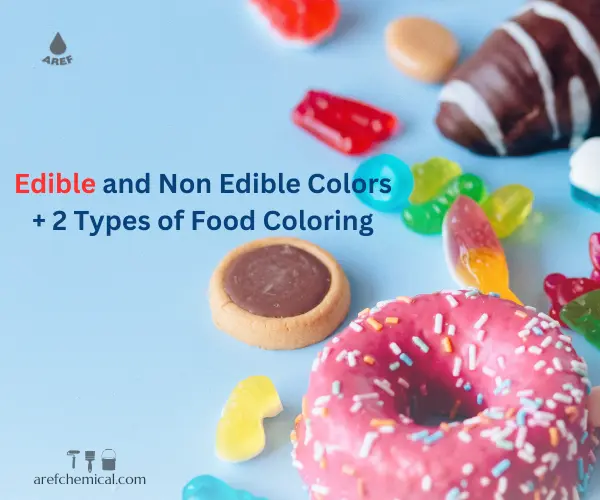
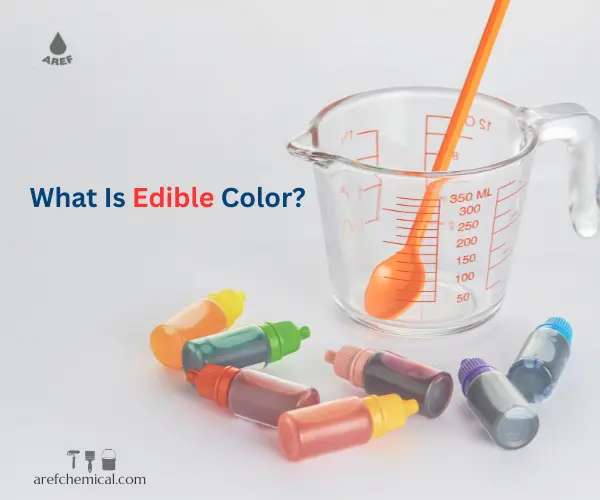
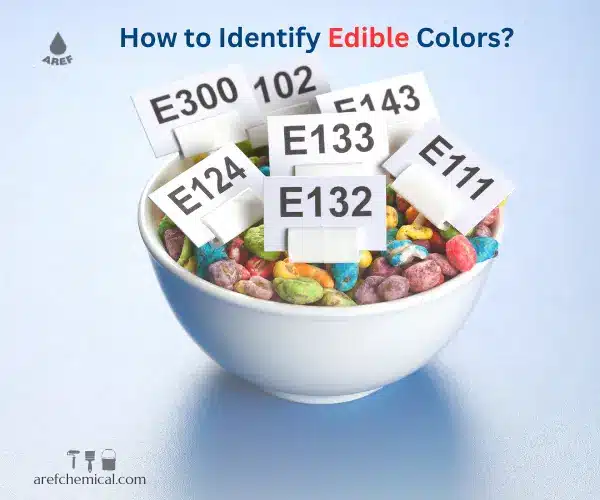
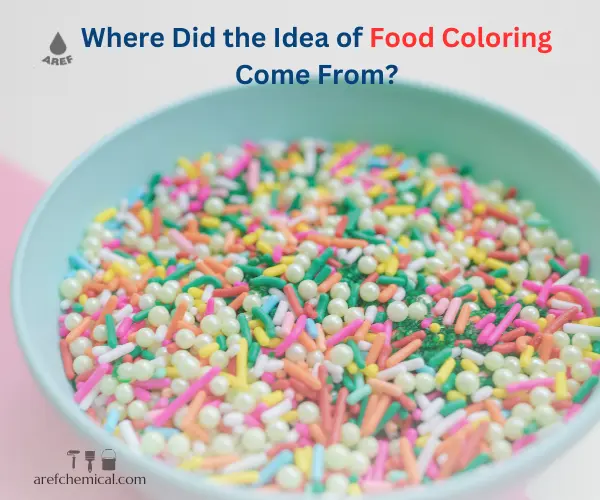

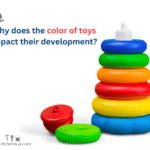
14 Responses
Colors can generally be categorized into edible and non-edible based on whether they are safe to consume or not.
Edible colors are dyes or pigments safe for consumption and are used in food, beverages, candies, bakery items, and other culinary creations.
They are specifically formulated to meet safety standards set by food regulatory authorities like the FDA (Food and Drug Administration).
Liquid food coloring: Usually made from water-soluble dyes.
Gel food colors: Thicker than liquid, used in icing and fondant.
Non-edible colors are dyes, paints, or pigments that are not safe for consumption. They are used in various non-food applications such as printing, painting, textiles, and crafts.
Natural colors: Derived from natural sources like:
Carotenoids (e.g., beta-carotene from carrots)
Anthocyanins (e.g., from berries)
Chlorophyll (green from leafy vegetables)
Turmeric (yellow)
Saffron (yellow-orange
Examples of Non-Edible Colors:
Food-grade dyes: For use in food packaging or as markers on food packaging.
Artist paints: Acrylics, oils, watercolors.
Ink dyes: Used in printing and writing.
Fabric dyes: For textile coloring.
Industrial pigments: Used in plastics and construction materials.
Food colorings are used in various ways in the food and cooking industry to make the appearance of foods and beverages more attractive and appetizing.
Food colorings are used in cakes, pastries, desserts, drinks, and various foods to enhance their appearance and attract consumers’ attention.
In some cases, food coloring is used to distinguish between different types of food or to indicate the level of heat or condition of the food, such as in children’s cakes or fresh foods, where the colors indicate what type of product it is.
In product packaging, food coloring can highlight logos or specific designs and reinforce the brand.
In the production of foods aimed at children, vibrant and attractive colors are used to stimulate purchases and increase children’s interest.
In some cooking classes and food workshops, food coloring is used as an educational tool to illustrate different stages of work or ingredients in the food preparation process.
It is true that food colorings are usually harmless, but they should be consumed in moderation and only use permitted, high-quality colors to maintain health.